Saturday, April 27th – It was the second of the two-day celebration of El Pasubat Festival in Taal. When we arrived there, it seemed too quiet to say that there’s a festival going on particularly when you’re expecting a grandiose street dance competition where drumbeats roar all over town.
Some El Pasubat Festival 2013 events
It was not really the ‘quiet, no noise at all’ scenario at the time we arrived. Walking towards Taal park, we heard someone reciting something in full Tagalog over the microphone. We then found out there’s a play, where young Taaleños clad in barong Tagalog and baro’t saya were retelling stories of the lives of 5 important natives of Taal who made a mark in the Philippine history.
 According to Arch. Robert Arambulo, Taal Tourism Coordinator, the play is basically about “Sinaunang Taal” depicting the lives of Juan Maningcad (Mamalakayan ng Pananampalataya), Gliceria Marella de Villavicencio (Godmother of the Philippine Revolution), Marcela Agoncillo (Ina ng Pambansang Watawat), Don Leon Apacible, and Jose W. Diokno.
According to Arch. Robert Arambulo, Taal Tourism Coordinator, the play is basically about “Sinaunang Taal” depicting the lives of Juan Maningcad (Mamalakayan ng Pananampalataya), Gliceria Marella de Villavicencio (Godmother of the Philippine Revolution), Marcela Agoncillo (Ina ng Pambansang Watawat), Don Leon Apacible, and Jose W. Diokno.
Walking around, we saw Mr. Dindo Montenegro (one of the prime movers in promoting the rich cultural-historical background of Taal) who informed us that members of the Camera Club of the Philippines (an elite group, we were told) were in town for the annual on-the-spot photo contest of the organization.
It’s the 4th time that they chose Taal as subject/location for their OTS photo contest. They were all to produce black and white photos – all showcasing anything about Taal. They can go wherever they want, take photos they want to do it for the rest of the day. As a pleasing treat, they will of course get to experience local Taal dining with the Heritage Town’s trademark dishes such as adobo sa dilaw, tapang Taal, suman, tamales, and tinindag (barbecue drenched in atswete marinade) to name some.
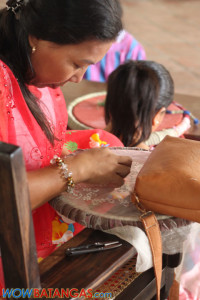 Moving a few meters from Taal park is the Escuela Pia where the exhibit of burdang Taal (Taal embroidery) was held. On display were Filipinianas with intricate hand-embroidered designs dating back the Illustrado years (1870-1900) up to the modern era.
Moving a few meters from Taal park is the Escuela Pia where the exhibit of burdang Taal (Taal embroidery) was held. On display were Filipinianas with intricate hand-embroidered designs dating back the Illustrado years (1870-1900) up to the modern era.
Revisiting the Villavicencio Wedding Gift House
In the first El Pasubat Festival, we were able to join some group of tourists in the Visita de las Casas (visiting heritage/ancestral houses). This time it’s kind of different as we can go search for an open house as long as they’re participating in the event.
The Villavicencio Wedding Gift House got a tarpaulin of the event on its gate so we went inside and found a group with a foreign tourist doing the house tour. The house, which was built in 1870, was Don Eulalio Villavicencio’s wedding gift to his bride, Doña Gliceria Marella de Villavicencio.
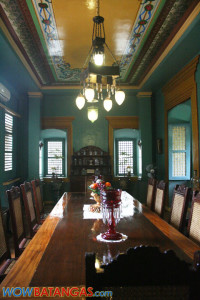 We took some photos and just like the first time, I got amazed by the huge mirrors hanging on the wall, facing each other. In the middle, an exquisite chandelier fit for hotels and mansions. Then we went downstairs and were about to leave when this lovely woman in white called us and ask us where we’re from. That’s Jocelyn Quiblat, a direct descendant of the Villavicencios.
We took some photos and just like the first time, I got amazed by the huge mirrors hanging on the wall, facing each other. In the middle, an exquisite chandelier fit for hotels and mansions. Then we went downstairs and were about to leave when this lovely woman in white called us and ask us where we’re from. That’s Jocelyn Quiblat, a direct descendant of the Villavicencios.
Ms. Jocelyn was so enthusiastic in welcoming us even after probably realizing that she’s got to repeat her touring and stories one more time for us. She’s so nice she made her storytelling so lively it’s like a midday energy pill.
The Villavicencio couple was active in supporting the Philippine revolution. They donated the Bulusan steamship – first ship of the fledging Philippine navy. Being a very affluent clan, the family financed the printing of Noli Me Tangere and El Filibusterismo in Hong Kong. Their responsibility was to distribute copies all over Batangas.
Vicente Ilustre, the Villavicencio couple’s son-in-law, was the first Senator of the Philippine Commission and was the inspiration of Rizal in the character of ‘Isagani’ in El Filibusterismo. Yes, they’re like buddy-buddy.
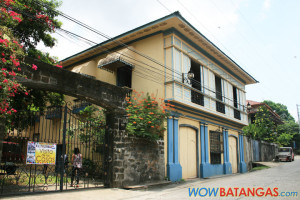 Majority of what you see in the house were personally used by the family and were all original. During the American period, the house was converted into hospital and there is still a hospital bed in there now. Ms. Jocelyn started the restoration of the house in late 1998 until 2003.
Majority of what you see in the house were personally used by the family and were all original. During the American period, the house was converted into hospital and there is still a hospital bed in there now. Ms. Jocelyn started the restoration of the house in late 1998 until 2003.
Aside from the huge mirrors and chandelier in the middle part of the house, other features no one would miss are the detailed Victorian-inspired wall decals on the second floor, the authentic azulejos tiles from Portugal which can be found on the other house entrance leading to main stairway, and the photos of Juan Luna’s paintings as gifts to the Villavicencios by Juan Luna himself.
The current modifications are for their bed & breakfast service. Yes, if you are planning to stay in Taal for two days and will be looking for a place to stay in, you can book a reservation at the Villavicencio Wedding Gift House where 6 persons can avail the family room for P6,500. P500 for every additional person and the rate is inclusive of a Taaleño breakfast, of course!
Galleria Taal, a photographer’s Disneyland
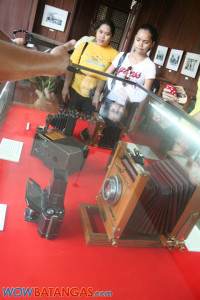 If you are a photographer or someone who fancies owning a collection of cameras, Galleria Taal could be your happiest place on earth. Like Disneyland for your kiddo. That’s if you don’t turn green with envy. Haha.
If you are a photographer or someone who fancies owning a collection of cameras, Galleria Taal could be your happiest place on earth. Like Disneyland for your kiddo. That’s if you don’t turn green with envy. Haha.
Galleria Taal is a camera museum, the first of its kind in the Philippines, is owned and managed by Mr. Manny Inumerable. Before it was transformed into a museum, it was the ancestral house of the Ilagan’s of Taal. Domingo Ilagan and Maria Martinez built their family here but years later, one of their children, Candida, got the sole ownership of the house after paying off her siblings.
Candida married Antonino Barrion, a lawyer and a delegate to the 1935 Constitutional Convention representing the 3rd district of Batangas and had three daughters including Nellie B. Inumerable, Sir Manny’s mother. When Candida passed away in 1975, the house was leased to tenants. Through the years, it got severe damages and in 2004, Sir Manny asked his mother to stop leasing the house and he’ll restore it instead.
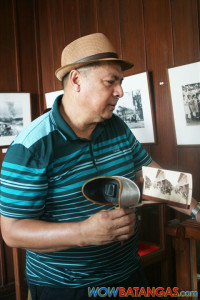 What is so amazing here is that even the very old and apparently huge box cameras are still working! Around 100 different cameras from different eras (from 1800’s to 2000’s), brands, and places of origin are displayed on the second floor of the house.
What is so amazing here is that even the very old and apparently huge box cameras are still working! Around 100 different cameras from different eras (from 1800’s to 2000’s), brands, and places of origin are displayed on the second floor of the house.
Probably the collection that’s most precious? His Leica cameras. Leica is considered the mother of all cameras and according to Sir Manny, it’s like the Hermes of camera brands. Of course, there’s an extensive collection of Nikon, Canon, and other brands you may not have heard of before.
But it’s not just his camera collections that will leave you awe-inspired. Have you seen a genuine photograph of Jose Rizal’s execution? If you’re trying to be a historian, you should see that photo hanging on the wall of Galleria Taal.
See Manila in the year 1940s down to the time of the first EDSA Revolution. The old photographs show how old some people’s passion for photography is. And how our history is worthy of being unraveled, documented, and captured through the lens all these years.
If you wish to visit Galleria Taal, you may contact Sir Manny Inumerable at mannyinumerable@yahoo.com and +639189124051 or Dolores Bautista (museum caretaker) at +639067632449.
And that’s all for El Pasubat 2013 experience. Hope you’d get to re-visit Taal one more time as well. 🙂
 WOWBatangas.com Your Source of Great News and Stories from the Province of Batangas, Philippines
WOWBatangas.com Your Source of Great News and Stories from the Province of Batangas, Philippines



